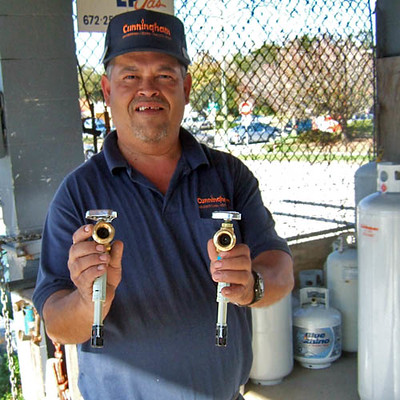
| Setup Type | Details | Advantages | Limitations |
|---|---|---|---|
| Single Regulator | When is one regulator sufficient? | Simplicity, cost-effectiveness | Pressure limitations, single-point failures |
| Best suited for residential settings with limited propane appliances. | Infrequent or predictable propane usage patterns. | Performance under high demand | |
| Consistent pressure for all connected devices. | |||
| Dual Regulator | Purpose of two-stage regulators | Stable pressure delivery, versatility in applications | Cost, complexity |
| Designed for systems with higher demands or variable needs. | Enhanced safety features | Potential over-complication for simple applications |
The need for two regulators in a propane system depends on several factors, including the types of appliances being used, the distance from the propane tank to the appliances, and the overall layout of the propane system. A two-stage regulator system, which uses two separate regulators, can enhance safety, improve pressure control, and provide more consistent performance for your propane appliances.
In a two-stage regulator system, the first-stage regulator is connected directly to the propane tank, while the second-stage regulator is installed closer to the appliances. The first-stage regulator reduces the high pressure of the propane coming out of the tank to a lower, more manageable pressure, typically 10 psi or less. The second-stage regulator further reduces the pressure to the required level for the safe and efficient operation of the appliances, usually around 11 inches water column (about 0.4 psi) for residential appliances.
There are several advantages to using a two-stage regulator system for your propane needs:
- Enhanced safety: A two-stage regulator system minimizes the risk of over-pressurization and the subsequent damage it could cause to appliances or gas lines. By reducing the pressure in two stages, the system ensures that propane is delivered to the appliances at the appropriate pressure, preventing potential accidents or malfunctions.
- Improved pressure control: Two-stage regulators provide more consistent pressure levels, ensuring better performance of your propane appliances. This is particularly important in situations where multiple appliances are being used simultaneously, as it helps maintain proper pressure for each appliance.
- Greater reliability: In the event of a failure in one regulator, the other can still provide some level of pressure reduction, minimizing the risk of a complete system shutdown. This redundancy is especially beneficial in critical applications, such as commercial or industrial settings, where propane supply disruptions could lead to significant downtime and losses.
- Better performance in cold weather: Two-stage regulators are less susceptible to freezing than single-stage regulators, making them more suitable for use in colder climates. When propane pressure is reduced in a single-stage regulator, the temperature of the gas can drop significantly, potentially causing the regulator to freeze. With a two-stage system, the pressure reduction is spread over two stages, reducing the risk of freezing.
- Greater adaptability: A two-stage regulator system can better accommodate changes in propane demand, as it can be adjusted more easily to handle fluctuations in usage. This makes it a more versatile option for a variety of applications.
However, there are some situations where a single-stage regulator may be sufficient, such as when using a small propane tank for a single, low-demand appliance like a barbecue grill. In these cases, a two-stage regulator system may not be necessary and could be seen as overkill. It’s important to consult with a professional propane supplier or installer to determine the best setup for your specific situation or if your regulator is properly.
While the use of two regulators in a propane system is not always necessary, it can offer several benefits in terms of safety, pressure control, reliability, and performance. By evaluating your specific propane needs and consulting with a professional, you can determine whether a two-stage regulator system is the best solution for your propane setup.
Comparing the Performance of the Two
| Scenario | Single Regulator Performance | Dual Regulator Performance |
|---|---|---|
| Consistent Usage | Single regulators perform best in conditions where propane consumption is predictable and steady. For example, a home with a single propane appliance like a stove would find a single regulator sufficient. | While they can handle consistent usage like single regulators, it may be overkill in scenarios with minimal or predictable demand. |
| High Demand | In situations where demand spikes suddenly, single regulators may falter. They are designed for consistency rather than adaptability. | Dual regulators shine in environments with fluctuating demands. The two-stage process allows for adaptability and more consistent pressure delivery. |
| Multiple Appliances | Using a single regulator for multiple appliances can lead to inconsistencies in pressure delivery if many appliances operate simultaneously. | For homes or businesses with multiple propane-fed appliances, dual regulators offer stable performance even when multiple appliances are in use at once. |
Consider Your Demand
| Factors | Single Regulator | Dual Regulator |
|---|---|---|
| Importance of Considering Demand | Ideal for situations with a consistent demand. When demand exceeds the regulator’s capacity, it can result in reduced appliance performance or even safety concerns. | With its two-stage process, it is more adept at handling variable demands, making it suitable for complex setups or commercial applications. |
| Appliance Requirements | Great for single-appliance setups or when all connected appliances have similar pressure requirements. | Beneficial for varied appliances with different pressure needs. The two-stage process ensures that each appliance receives the right pressure. |
| Temperature Fluctuations | Propane pressure can vary with temperature. Single regulators may not handle these fluctuations as efficiently. | Dual regulators, with their two-stage adjustment, can better handle these changes. |
| Altitude Changes | At higher altitudes, single regulators may not provide the necessary precision in pressure adjustments. | At higher altitudes, the boiling point of propane decreases. A dual regulator system can offer more precise pressure adjustments in such conditions. |
When a Single-Stage Regulator May Be Sufficient
Small propane tank usage
In some situations, a single-stage regulator can be sufficient for your propane needs. This is particularly true when you are using a small propane tank for a limited purpose. For example, if you are using a portable propane tank for an outdoor grill, a single-stage regulator may adequately control the pressure and provide a safe and efficient propane flow for the appliance. In such cases, the simpler design and lower cost of a single-stage regulator can be more practical.
Low-demand appliances
A single-stage regulator can also be appropriate when you are only operating a low-demand appliance. Low-demand appliances, such as outdoor patio heaters, clothes dryers or portable stoves, typically have a lower propane consumption rate and require less precise pressure regulation than more complex appliances like furnaces or water heaters. Since the pressure requirements for these appliances are more lenient, a single-stage regulator can often deliver the necessary pressure without the need for a two-stage system.
When a Two-Stage Regulator Should Be Used?
A two-stage regulator should be used in situations where enhanced safety, improved pressure control, greater reliability, better performance in cold weather, and adaptability are required. Some specific scenarios where a two-stage regulator system is recommended include:
- Residential and commercial applications: Two-stage regulators are commonly used in residential and commercial settings, where multiple appliances with varying pressure requirements are in use. The two-stage system ensures consistent pressure delivery to each appliance, enabling them to operate safely and efficiently.
- Long gas line runs: If the propane tank is located far from the appliances, pressure loss can occur along the gas line. A two-stage regulator system can help maintain consistent pressure throughout the entire length of the line, ensuring proper functioning of the appliances.
- High propane demand: In situations where propane consumption is high, such as in commercial kitchens or industrial applications, a two-stage regulator can better accommodate fluctuations in demand and provide stable pressure to all connected appliances.
- Cold climates: Propane pressure can drop significantly as the temperature decreases, potentially causing a single-stage regulator to freeze. A two-stage regulator system reduces the pressure in two stages, minimizing the risk of freezing and ensuring better performance in cold weather.
- Redundancy and reliability: For critical applications where the propane supply cannot be disrupted, a two-stage regulator system provides an added layer of reliability. If one regulator fails, the other can still provide some level of pressure reduction, reducing the risk of a complete system shutdown.
- Appliances with sensitive pressure requirements: Some appliances, such as tankless water heaters or high-efficiency furnaces, may have more sensitive pressure requirements. A two-stage regulator can ensure precise pressure control, allowing these appliances to function optimally.
Do You Have Your Own Specific Needs
| Scenario | Recommendation |
|---|---|
| Residential use: grills, heaters, etc. | For most residential settings with a limited number of propane appliances such as grills and heaters, a single regulator should suffice. However, if there’s a mix of several propane appliances being used simultaneously or intermittently, considering a dual regulator might provide more consistent performance. |
| Commercial use: restaurants, industrial heaters, etc. | Commercial settings, especially restaurants and places with industrial heaters that have variable demands, would benefit greatly from the adaptability of a dual regulator. The consistent pressure delivery and safety features of dual regulators make them more suitable for such demanding environments. |
| High-altitude settings: implications of pressure changes. | At higher altitudes, the boiling point of propane decreases and pressure can be impacted. A dual regulator system is recommended as it offers precise pressure adjustments suited for these conditions, ensuring consistent propane delivery and appliance performance. |
Don’t Forget Maintenance
| Aspect | Single Regulator | Dual Regulator |
|---|---|---|
| Differences in Installation Complexity | Installing a single regulator is typically straightforward. Most residential propane users can manage this with basic guidance, although professional installation is always recommended for safety reasons. | Dual regulators, with their two-stage setup, are inherently more complex. Professional installation is more often than not essential for these systems. |
| Maintenance Frequency | With fewer components, single regulators generally require less frequent checks. Inspections are still vital periodically, especially if performance inconsistencies are noticed. | Given their complexity, dual regulators might require more frequent checks and maintenance. Ensuring both stages function optimally is crucial. |
| Long-Term Cost Implications | The initial cost is typically lower, with minimal maintenance costs over time if well-maintained and used under normal conditions. | While the initial investment might be higher, potential frequent maintenance can add up over time. However, benefits might outweigh these costs in certain environments. |
In Conclusion
The decision to use a single-stage or two-stage regulator system for your propane setup is an important one that can impact the safety, efficiency, and performance of your propane appliances. By consulting with a professional propane supplier or installer, you can ensure that you choose the most appropriate regulator system for your specific needs and circumstances.
Professionals can assess your propane usage, appliances, and gas line layout, and recommend the best solution based on their expertise and knowledge of local codes and regulations. They can also provide guidance on proper installation, maintenance, and troubleshooting to ensure the longevity and reliability of your propane system.
Ultimately, prioritizing safety and efficiency when working with propane systems is essential. By seeking professional guidance and carefully considering your unique situation, you can create a propane setup that is both safe and optimized for your needs.

Mike is an experienced propane technician with over 15 years of professional experience in the field. He has dedicated his career to helping customers with their propane needs, from installation to maintenance and repair. Together with Jeremy, he co-founded this website to provide useful information and guidance to customers seeking reliable propane services.



